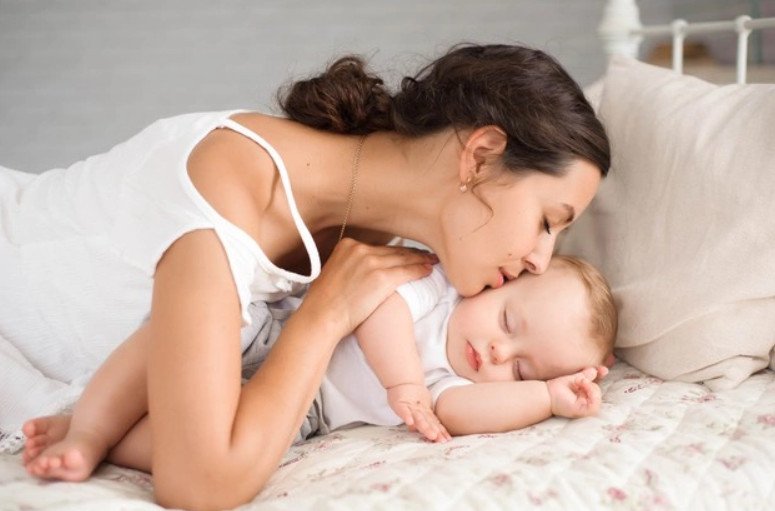The risks and benefits of co-sleeping with a baby are controversial among parents. Some parents feel that bed is the right place for the baby. However, there are also those who are worried that this application is not safe.
Co-sleeping is a practice where parents and children share a bed. Some of the benefits of sleeping together are that it can help reduce the risk of SIDS, increase attachment time, and reduce separation anxiety.
Many people use the phrases “sharing the bed” and “sleeping together” to sleep with the baby, but they’re not exactly the same.
Sleeping with the baby also comes with some risks, such as choking. Parents should be aware of these risks when deciding whether or not to sleep with their child.
Sleeping with the baby
sleeping with the baby; means he sleeps tight physically and socially so everyone knows the other is next to him.
Sharing a room and sleeping with the baby are two different options:
share the room; There is a cot in the parents’ room. The room is divided by placing a portable cot next to the parents’ bed or an extra bed where the baby sleeps next to the parents’ bed.
sleeping with the baby; It’s when parents and baby sleep together in the same bed. This issue has raised concerns that sharing a bed with an infant increases the risk of death related to sleep patterns, including the risk of sudden infant death syndrome (SIDS).
Why are there parents who want to sleep with the baby?
Advocates of bed sharing with the baby believe, and there are some positive thoughts that support these beliefs.
Sleeping with the baby promotes breastfeeding and makes nighttime breastfeeding more comfortable. Using the same bed as the baby makes it easier for the mother to synchronize her sleep cycle with that of her baby. It helps babies fall asleep more easily, especially during the first few months and when they wake up in the middle of the night. It helps babies sleep better at night.
Co-sleeping helps parents who are away from their babies during the day to be closer to their babies at night.
Is it safe to sleep with the baby?

In many cultures, co-sleeping is common and infant mortality rates are lower. Differences in mattresses, bedding and other cultural practices may mean that this risk is low.
In addition to the potential risks to the baby’s safety, sleeping with a baby can prevent you from resting and sleeping at night. Additionally, babies who sleep with their parents learn to associate bedtime with proximity to one of their parents and their parents’ bed. This can become a problem before bedtime.
sudden infant death
Despite the potential benefits, we do not consider it safe for your baby’s safety to sleep with your baby. Bed sharing puts babies at risk of suffocation and SIDS. Studies have found that bed sharing is the number one cause of death in infants, especially children under the age of three months.
It is known that older babies (4 to 12 months) who die as a result of sleeping with the baby are due to the presence of excess items such as pillows or blankets.
The risk of death for a baby sleeping with their parents is particularly high if they are sleeping between two people and the parents are very tired.
Safely share the room with the baby
When parents share the room with the baby, they have many options to avoid the risks of sharing. To keep your baby close to you at night but not in the same bed:
Put a crib or portable crib next to your bed. This way you can maintain the intimacy you desire. This can be especially important if you are breastfeeding your baby. Letting the baby sleep in his own room in the same room as his mother reduces the risk of SIDS.
How is it safe to sleep with the baby?

Despite the risks, some parents decide that co-sleeping with the baby is best for their family.
The American Academy of Pediatrics recommends avoiding the shared bed for newborns around 6 months of age.
A baby should always be in a separate cradle or bassinet for safety reasons, but that doesn’t mean they sleep separately. When you put your baby to sleep, leave him in your room but close the door so you can hear him cry if he needs anything.
If you insist on co-sleeping with the baby, take the following precautions:
- Do not share the bed with an infant under four months.
- Always put your baby on their back to sleep to reduce the risk of SIDS.
- Dress the baby as little as possible to avoid overheating.
- Do not put the baby alone in the adult bed.
- Don’t let your baby sleep on a soft surface like a soft mattress or sofa.
- Make sure the head and foot of the bed do not have any openings or gaps for the baby’s head to enter.
- Make sure the bed frame fits snugly against the bottom of the bed to prevent the baby from getting trapped between them.
- Do not cover baby’s head while sleeping.
- Do not use pillows, blankets, duvet covers, bedspreads, or other soft, padded, or fluffy items on the bed.
- Instead of a blanket, dress your baby well.
- Don’t fall asleep with the baby while breastfeeding.
- If you breastfeed your baby at night, make sure you are fully awake, never breastfeed your baby lying down or half asleep.
- Make sure you get up and move around at night before breastfeeding, then switch to seated breastfeeding.
- Don’t sleep with your baby on a sofa, rocking chair, or lounge chair.
Baby sleeps in his own room
Experts recommend that babies sleep in their parents’ room on day one. If parents prefer the baby to sleep in their own room, it is best to wait until they are at least six months old.
Experts recommend parents to leave their babies in the room for at least the first night. This allows them to get used to sleeping in a safe and familiar environment as quickly as possible.
Experts recommend parents to keep their babies in the same room the first night to avoid separation anxiety and to get their babies used to sleeping in a safe environment. Your mother too emotional attachment to the baby Therefore, they are less likely to develop unhealthy attachment behaviors.
Our previous post What is Birth Trauma? in our article birth trauma, birth trauma examples ve birth trauma injury lawyers information about.














